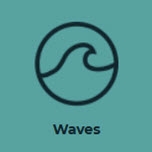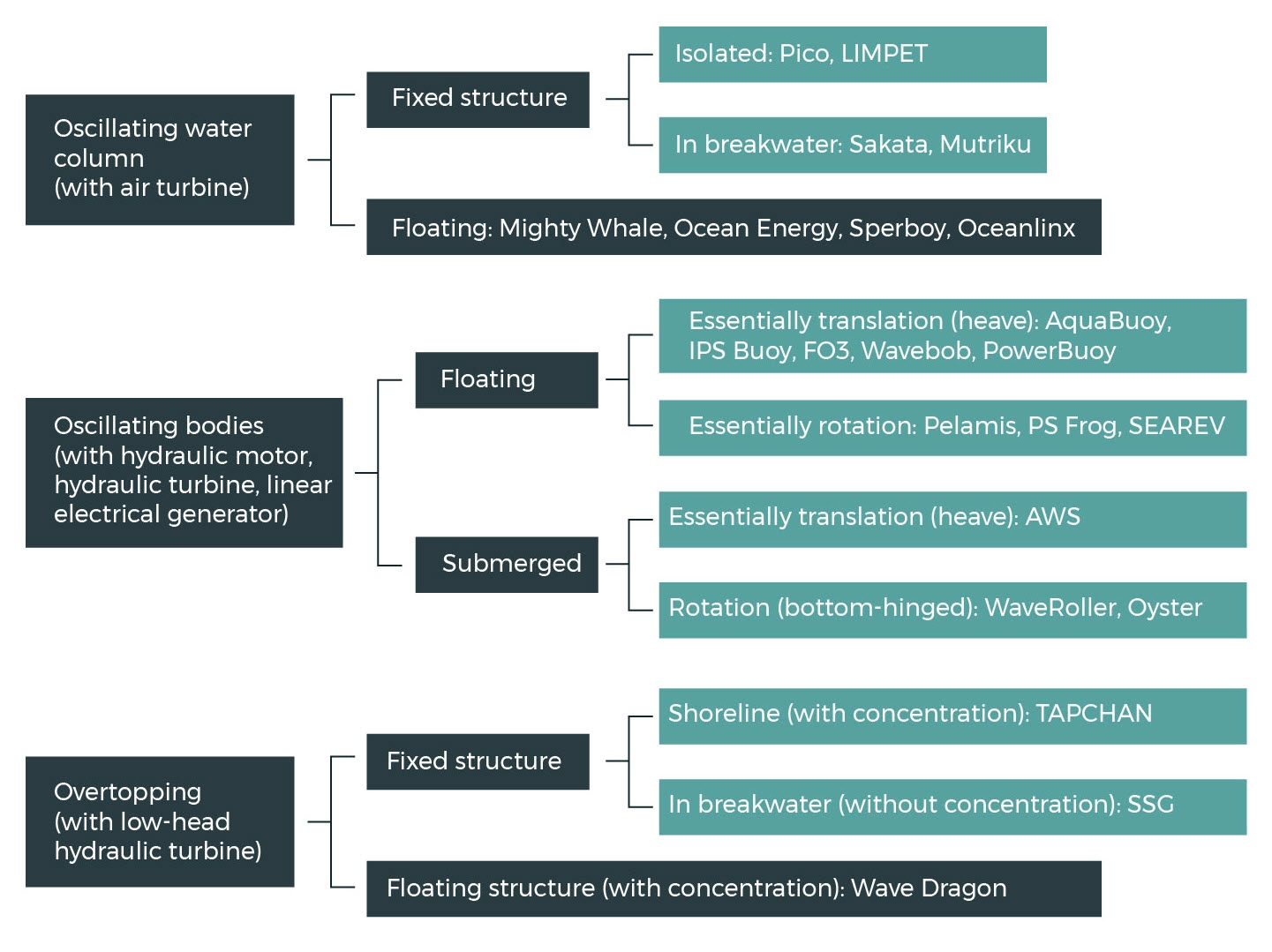

Introduction

The energy from surface waves is the most conspicuous form of ocean energy, possibly because of the, often spectacular, wave destructive effects. The waves are produced by wind action and are therefore an indirect form of solar energy. The possibility of converting wave energy into usable energy has inspired numerous inventors: more than one thousand patents had been registered by 1980 and the number has increased markedly since then.
Yoshio Masuda may be regarded as the father of modern wave energy technology, with studies in Japan since the 1940s. He developed a navigation buoy powered by wave energy, equipped with an air turbine, which was in fact what was later named as a (floating) oscillating water column (OWC). These buoys were commercialized in Japan since 1965 (and later in USA).
The oil crisis of 1973 induced a major change in the renewable energies scenario and raised the interest in large-scale energy production from the waves. The British Government started in 1975 an ambitious research and development program in wave energy (followed shortly afterwards by the Norwegian Government), but its funding came almost to a halt by 1982. In Norway, the activity went on to the construction, in 1985, of two full-sized (350 and 500kW rated power) shoreline prototypes near Bergen. In the following years, until the early 1990s, the activity in Europe remained mainly at the academic level, the most visible achievement being a small (75 kW) OWC shoreline prototype deployed at the island of Islay, Scotland (commissioned in 1991). At about the same time, two OWC prototypes were constructed in Asia: a 60 kW converter integrated into a breakwater at the port of Sakata, Japan, and a bottom-standing 125 kW plant at Trivandrum, India.
The situation in Europe was dramatically changed by the decision made in 1991 by the European Commission of including wave energy in their R&D program on renewable energies. Since then, about thirty projects on wave energy were funded by the European Commission involving a large number of teams active in Europe. In the last few years, growing interest in wave energy is taking place in the USA, Canada, South Korea, Australia, New Zealand, Brazil, Chile, Mexico, and other countries.
The wave energy resource
The main disadvantage of wave power, as with the wind from which it originates, is its (largely random) variability in several time-scales: from wave to wave, with sea state, and from month to month (although patterns of seasonal variation can be recognized).
The studies aiming at the characterization of the wave energy resource, having in view its utilization, started naturally in those countries where the wave energy technology was developed first. This was notably the case of the United Kingdom. The WERATLAS, a European Wave Energy Atlas, whose preparation was funded by the European Commission in the mid-1990s, remains a basic tool for wave energy planning in Europe. More detailed wave energy atlases (including the near-shore and shoreline resources) were produced later in several countries for national purposes.
The wave energy level is usually expressed as power per unit length (along the wave crest); typical values for “good” offshore locations (annual average) range between 20 and 70 kW/mand occur mostly in moderate to high latitudes. Seasonal variations are in general considerably larger in the northern than in the southern hemisphere, which makes the southern coasts ofSouth America, Africa, and Australia particularly attractive for wave energy exploitation.
Hydrodynamics
The study of the hydrodynamics of floating wave energy converters could benefit from previous studies on the, largely similar, dynamics of ships in wavy seas, that took place in the decades preceding the mid-1970s. The presence of a power take-off mechanism (PTO) and the requirement of maximizing the extracted energy introduced additional issues.
The first theoretical developments addressed the energy extraction from regular (sinusoidal) waves with a linear PTO. An additional assumption of the theory was small-amplitude waves and motions. This allowed the linearization of the governing equations and the use of the frequency-domain analysis.
Since, in practice, most converters are equipped with strongly nonlinear mechanisms, the time-domain theory had to be developed. The time-domain model produces time-series and the appropriate tool for active-control studies of converters in irregular waves. However, it requires much more computing time as compared with the frequency-domain analysis.
Large numbers of devices in arrays are required if wave energy is to provide a significant contribution to large electrical grids. The hydrodynamic interaction between devices in the array is extremely complex and approximate methods have in practice to be devised, like the multiple-scattering method, the plane-wave method, and the point-absorber approximation.
The utilization of wave energy involves a chain of energy conversion processes, each of which is characterized by its efficiency as well as the constraints it introduces and involves control procedures. Particularly relevant is the hydrodynamic process of wave energy absorption. The early theoretical studies on oscillating-body and OWC converters revealed that, if the device is to be an efficient absorber, its own frequency of oscillation should match the frequency of the incoming waves, i.e. it should operate at near-resonance conditions. The amount of absorbed wave energy can be significantly increased by adequately controlling the PTO in order to achieve near-resonance. Phase control (including latching control) in real random waves is a difficult theoretical and practical problem that is far from having been satisfactorily solved.
In the development and design of a wave energy converter, the energy absorption may be studied theoretically/ numerically, or by testing a physical model in a wave basin or wave flume. The techniques to be applied are not very different from those in the hydrodynamics of ships in a wavy sea. Numerical modeling is to be applied in the first stages of the plant design. The main limitations lie in its being unable to account for losses in water due to real (viscous) fluid effects (large eddy turbulence) and not being capable to model accurately large-amplitude water oscillations (nonlinear waves). Such effects are known to be important (they also occur in naval engineering and in off-shore structures, where more or less empirical corrections are currently applied). For these reasons, model tests (scales 1:80 to 1:10) are carried out in wave basin when the final geometry of the plant is already well established. As the development of the wave energy converter progresses towards the prototype construction stage, the need for large-scale testing requires the use of very large laboratory facilities. This was the case, in Europe, of the large wave tanks in Trondheim (Norway) and Nantes (France).
The various technologies
Unlike large wind turbines, there is a wide variety of wave energy technologies, resulting from the different ways in which energy can be absorbed from the waves, and also depending on the water depth and on the location (shoreline, near-shore, offshore). Recent reviews identified about one hundred projects at various stages of development. The number does not seem to be decreasing: new concepts and technologies replace or outnumber those that are being abandoned.
Several methods have been proposed to classify wave energy systems, according to location, working principle, and size (“point absorbers” versus “large” systems).
The classification in Table 1 is based mostly on the working principle. The examples shown are not supposed to form an exhaustive list and were chosen among the projects that reached the prototype stage or at least were objects of extensive development effort.

Table 1 – Wave energy technologies.